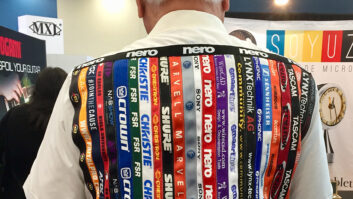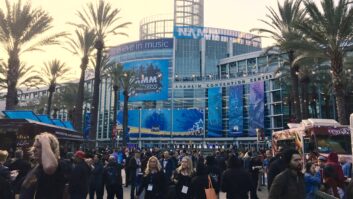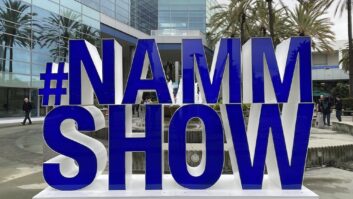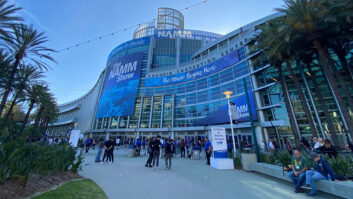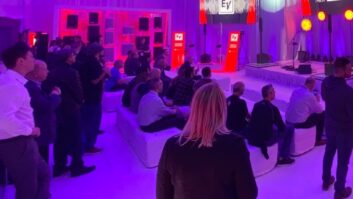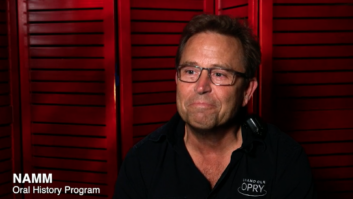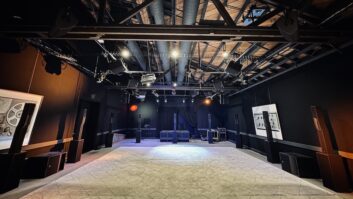From January 16 to 19, 2003, a record-setting 65,000-plus music and audio pros made the pilgrimage to Anaheim, Calif., for the semi-annual expo of the International Music Products Association (NAMM). If the economy is slow, you wouldn’t know it from this show, and NAMM attendees came to p-a-r-t-y! The main attraction was the NAMM/Yamaha Elton John concert with 13,000 showgoers dropping by the Arrowhead Pond arena for a private performance by Sir Elton and a host of others, including Ray Charles, Norah Jones, Brian Wilson and Diana Krall. Other hot NAMM nightlife included Shure’s evening with Cheap Trick, Sennheiser’s Goo Goo Dolls show and the Telex/E-V party with the English Beat. Fun!
Back to work: Inside NAMM’s six cavernous exhibit halls — where 1,309 companies showed the latest audio and music instrument technologies — the mood was upbeat, with aisles packed by eager buyers. And, as with past shows, there was no shortage of cool, futuristic (and retro-istic) gear to check out. Here are some of our favorites.
SHOWSTOPPERS!
Every show has a few “gotta-see-it” hits. This time, the focus was on synths and consoles. The stars at Roland (www.rolandus.com) were VariOS and V-Synth. VariOS is an open-ended hardware/software processing system (in a 1U module) that lets users independently tweak pitch, time and formant; add effects; and build audio-based arrangements — in real time and without CPU drain — via Roland’s bundled V-Producer software. V-Synth is like getting all of Roland’s gear in one box. This 61-note instrument features Variphrase pitch/time/formant manipulation, COSM processing and multi-effects, and the ability to sample custom waveforms and exchange .WAV/.AIFF files via USB. The coolest part? V-Synth’s expressive real-time control via twin infrared D Beams and Roland’s new TimeTrip pad (a touch pad for changing a waveform’s time aspects, such as speed up, slow down, reverse and freeze).
Austin, Texas-based Open Labs (www.openlabs.com) announced eKo, the world’s first open-platform musical keyboard instrument/workstation, based on the OpenSynth™ hardware/software platform. Combining powerful synthesis/sampling/sequencing/multitrack digital re- cording/editing in a single product with full VST plug-in and VSTi virtual instrument support, eKo defines a new class of superinstruments with a chameleonlike power to become whatever its user requires. And customers can spec the exact product they desire — priced from $1,995 to $5,200 — with the ability to upgrade anytime. Deliveries begin Q2 ’03.
Korg kicked off its 40th anniversary at NAMM with a display of treasured vintage products. Go to www.korg.com to check out an interactive timeline of the company’s accomplishments.
The Yamaha (www.yamaha.com/proaudio) 01V96 low-cost/high-performance digital mixer has 24-bit/96kHz capacity, 40 channels on remix, 100mm moving faders and automation of all console parameters. Also standard are 32-input compressor/gates, 4-band parametric EQ, delay, up to four onboard 32-bit effect processors (two at 96 kHz) and built-in ADAT Lightpipe I/O. A single I/O expansion slot accepts existing or new Mini-YGDAI cards, providing up to 16 I/Os at 48 kHz — or eight at 96 kHz — as well as the Waves Y56K expansion card. The 01V96 integrates with Pro Tools, Nuendo and other DAWs. It ships in April; retail is $2,499.
Neve guitars? Dissatisfied with the performance of acoustic guitar electronics, pickup designer David Hosler, of Taylor Guitars (www.taylorguitars.com), teamed with legendary audio guru Rupert Neve to create the Expression System. Exclusive to select Taylor guitars, ES combines two vibrational Dynamic Body Sensors™ and a subfretboard Dynamic String Sensor™, the three of which are precisely blended via high-end electronics. Users can select from EQ voiced especially for acoustic guitar or Pure Path® (flat) signals; both onboard and external preamp versions are available.
WORKSTATIONS AND MORE
Cakewalk‘s (www.cakewalk.com) Project5 is an open-platform workstation combining soft synths, instruments and samplers with pattern-based sequencing, mixing and editing tools; automatable effects; and looping. In addition to supporting DXi and VSTi instruments, the app works with WDM, MME or ASIO-compatible Windows hardware and can be integrated with a ReWire-compatible host (such as Cakewalk’s Sonar) for recording, editing and mixing. Project5 lists at $429. Cakewalk has also added ASIO support to Sonar, available as a free upgrade.
MOTU‘s (www.motu.com) MachFive universal sampler plug-in handles up to 24-bit/192kHz audio and can import and play multichannel samples in surround; it supports all major formats and imports all major audio-file, sample and soundbank formats. Users can move from one workstation platform to another or collaborate across platforms; the software is both Mac and PC-compatible. Each multitimbral part can have up to four unique effects; a multichannel waveform editor is built-in.
Native Instruments (www.native-instruments.com) showed several new software packages. The coolest was Intakt, a software sampler designed for loop playback and editing in a single-screen interface. Intakt can divide imported audio into individual hits, with individual settings for pitch, playback direction, pitch envelope and other characteristics; sound can be time-stretched or compressed in real time and shaped via multimode filter, an envelope follower, two LFOs and effects. A library of loops from Zero-G and East West is included. NI also showed the Kompakt sampler, Version 4 of Reaktor, the Vokator vocoder and Reaktor Session.
At first, it seemed the biggest news at Steinberg (www.steinberg.net) was its acquisition by video company Pinnacle. But the real buzz was virtual instruments. New are D’cota, an eight-way multitimbral VST synth combining analog, spectrum and wave-impulse synthesis; V-stack, a virtual 32-bit instrument rack for up to 16 VST instruments; HALion String Edition; the “electric” version of Virtual Guitarist; and VSL 2020, an ultra-low-latency ASIO soundcard to play VST instruments live. Also, Nuendo 2.0 was about to ship at press time.
Ableton (www.ableton.com) introduced LIVE Version 2. The upgrade adds multitrack recording and editing with Elastic Audio, a feature that lets users set tempo any time during recording, performance or playback, as well as drop in recordings, loops and complete songs that play in sync. In addition, time stretching can now be applied to any audio material. Also included in LIVE 2 are real-time effects, dynamic parameter automation and unlimited undo.
Akai (www.akaipro.com) demoed a software version of the Z8 rackmount sampler: The VZ8 is a 24-bit/96kHz VSTi/ Audio Unit sampler that offers more than 64-voice polyphony per instance, with each instance allowing up to 19 layers assignable to 16 MIDI channels; multiple instances can be opened (depending on CPU power); a variety of effects and editing features are included.
Emagic (www.emagic.de) announced Version 6 of the Logic Series, boasting improved processor efficiency (users can now “freeze” CPU-demanding tracks to reduce load), interface enhancements (such as an Arrange Channel Strip function that allows the user to perform on-the-spot changes to the mix while editing in the Arrange window), and an intelligent Project Manager, plus film-scoring enhancements, new track EQ, MP3 import/export and automation enhancements. Logic 6, available for Mac OS 9.x and Mac OS X, was slated to ship in February.
In other software news, Propellerhead Software (www.propellerheads.de) announced plans with Digidesign (www.digidesign.com) to develop ReWire 2 support for Pro Tools. It also showed Reload, which lets Reason and ReCycle users load Akai S1000 and S3000 sounds.
We got a backroom peak at Quantegy‘s (www.quantegy.com) secret new project: The FHD DrivePak combines an ultrareliable (two-year warranty) 80 or 120GB FireWire external hard drive, with IEEE-1394 and power cables, in a foam-lined case with space for everything, including AIT/DLT/LTO backup media. With all those goes-intas and goes-outtas in DAW-based studios, analog patching can be a problem. One solution from MotorMix manufacturer CM Labs (www.cmlabs.net) is the SixtyFour, a 32×32 studio router with programmable level control. The two-rackspace unit’s 32 ins and 32 outs (all on D25-sub connectors) offer 1,024 instantly recallable crosspoints for fast, patchcord-free production.
Continuing on NAMM’s “all-in-one” gear vibe, M-Audio‘s (www.m-audio.com) Ozone is a laptop-size unit with 25-note keyboard, MIDI control surface, mic pre and USB audio/MIDI interface. Combined with a computer running apps like Reason or Live, Ozone forms a full mobile studio. Audio I/Os include XLR mic in (with preamp and phantom power), a ¼-inch TRS input and unbalanced ¼-inch stereo aux inputs — all can be routed to the computer or directly to Ozone’s audio outs.
DAWs: Expensive? Not any more. The DigiTech (www.digitech.com) RP×400 is a full-featured, multi-effects guitar pedalboard with a few extras, such as guitar, XLR mic and stereo line inputs, and balanced outs for simultaneous USB interfacing to computers using included Cakewalk multitrack recording software. With its onboard rhythm programmer and digital tuner, it’s everything you need — almost. MSRP is $374.95.
SIGNAL PROCESSING
Kurzweil (www.kurzweilmusicsystems.com) showed two 1U processors featuring stereo effects adapted from its flagship KSP8: The Rumour has reverbs and reverb variations, including gated, reverse, reverb/compression combos and Kurzweil’s LaserVerb. The Mangler offers a variety of effects, including reverb, chorus, flanger, phaser, tremolo, rotary-speaker emulation, panner, delay, filters and more.
Exciting news at Presonus (www.presonus.com): The company announced that it’s joining forces with Anthony Demaria Labs (www.adl-tube.com) to develop a new line of tube-based audio products, known as the ADL Series. The first product, a stereo tube preamp, will launch at AES Europe.
Plug-ins were as hot as ever at the show. Eventide (www.eventide.com) wowed us with its new Clockworks Legacy plug-ins for Pro Tools|HD, featuring plug-in versions of Eventide’s classic boxes, including the H910, Omnipressor, Instant Phaser, Instant Flanger and H949. We also saw major upgrades for Orville, Eclipse and DSP700/DSP7500 processors and got news that the much-anticipated Plugzilla should be shipping in April!
There was a lot happening at the TC Electronic (www.tcelectronic.com) booth: The company showed Reverb 4000, a stereo version of the System 6000; TC Helicon (www.tc-helicon.tc) has two new vocal-harmony processors, the TC-Helicon VoiceWorks and the TC-Helicon Quintet; and TC Works (www.tcworks.de) showed Spark XL 2.7, with OS X support and direct CD-burning capability. In PowerCore news, the Assimilator plug-in is shipping, and an OS X driver is available.
Sony‘s (www.sony.com) latest Oxford plug-in, The Inflator, warms up audio material with an increase in apparent loudness, without loss in quality or audible reduction of dynamic range, so users can add presence without increases in peak signal level. The plug-in will be available this spring for PowerCore and Pro Tools systems.
Mackie (www.mackie.com) announced it would receive about $6.3 million dollars from an investment by Sun Capital. In plug-in land, there were two new Universal Audio Powered Plug-ins for the Mackie UAD-1 DSP card, the Cambridge EQ (a 5-band parametric EQ) and DreamVerb, a stereo reverb built on Real-Verb Pro’s acoustic-morphing capabilities and featuring a 5-band EQ and level ramping for early and late reflections. Mackie also showed Saturated Fat, a new mono tube-distortion/cabinet-modeling plug-in for Soundscape 32, developed by Acuma Labs. Another hit was Version 5 software for the Digital 8•Bus, which adds a revamped graphical interface, HUI emulation and surround monitoring control.
Apogee (www.apogeedigital.com) unveiled its Mini-DAC, a compact, 192kHz D/A converter with AES, optical (ADAT, S/MUX and S/PDIF) and S/PDIF co-ax ins; XLR, ¼- and ¼-inch analog outs and USB I/O. Apogee’s Big Ben 192kHz Master Word Clock is a souped-up studio timepiece that handles AES, S/PDIF, optical I/O and wordclock/video in, with six wordclock outs. A FireWire card option keeps it current.
THE LISTENING POST
Alesis (www.alesis.com) floored us with its ProActive 5.1 system — a complete, powered 5.1 surround monitoring system with analog and digital I/O, onboard DVD surround decoding, five satellite speakers, a compact subwoofer (housing 450 watts of system amplification) and wireless remote. Beyond its obvious applications (gaming production/edit suite playbacks), the ProActive 5.1 could be the Auratone for the new millennium: a real-world surround reference system in larger studios. Retail? $399!
AKG (www.akg.com) followed up on its successful K141 Studio and K240 Studio units with the closed-back, supra-aural K171 Studio and circumaural K271 Studio models. All share 1.2-inch drivers with patented Varimotion technology that creates diaphragms of varying thickness: thinner around the outside for improved LF tracking and a thicker center for accurate MF/HF response. Other improvements include a detachable cable with a secure mini-XLR connection.
When Wharfedale Pro (dist. by www.iagamerica.com) hit U.S. shores last year, we loved the low-cost Diamond Series monitors taken from its consumer catalog. Now, Wharfedale has a similar — but beefed-up — line of pro monitors featuring black finishes and built-in mag shielding, ranging to a high-performance top-end model in a gorgeous, high-gloss piano-black finish. Keep your eyes — and ears — on these.
We checked out Event Electronics‘ (www.event1.com) new monitors and especially liked the Studio Precision 8, the top of Event’s new flagship Studio Precision Series (powered or unpowered). These sleek new monitors, built on all-new technology from Event, are available in active (280W) or passive versions, in 8-inch or 6.5-inch models. All models use the 1-inch, soft-dome, high-frequency radiator with neodymium magnet, and Event’s exclusive dual large-diameter linear-flow bass ports for deeper, more accurate bass. Also new is the Tuned Reference 8XL, the latest in Event’s Tuned Reference Biamplified Direct Field Monitors Series, having the same drivers as the original TR8 but pumped up with new amps delivering 150 watts (100 woofer/50 tweeter) to each speaker.
KRK (www.krksys.com) unveiled the newest incarnation of the E8, the great-sounding E8T. This two-way, 260-watt, bi-amped (Class-A and A/B) design features KRK’s new titanium-oxide dome tweeter, 24dB/octave filters and HF attenuation control. Bag End‘s (www.bagend.com) compact new two-way M6 near-field monitors measure 4×9×9 inches, weigh 15 pounds and are priced below $600. The S21E-C is a high-output, 21-inch subwoofer that boasts a response down to 8 Hz when controlled with the Bag End ELF.
And now for something completely different: French manufacturer Focal Professional (www.focal-fr.com) showed off its SM11 Utopias, tri-amped monitors featuring Beryllium tweeters, 24-bit/96kHz converters and built-in DSP algorithms for EQing options. The units can be controlled remotely via a PDA. And you thought your Palm Pilot was just for phone numbers and restaurant reviews.
GOTTA HAVE MICS!
NAMM’s coolest-mic-design award has to go to Blue Microphones‘ (www.bluemic.com) Ball. This phantom-powered dynamic mic (yes, you read that correctly) is unique-looking even among BLUE mics, especially with its spherical design resembling a blue baseball. The Ball is a cardioid pattern, and stated specs are impressive, listing a 35 to 16k Hz response and 146dB max SPL.
The AT3060 tube microphone from Audio-Technica (www.audiotechnica.com) operates on standard 48V phantom power — and doesn’t need a separate power supply — for fast, easy setups. The mic features a new large-diameter diaphragm, cardioid-condenser element, a hand-selected tube and a large coupling transformer. It’s available in spring 2003; MSRP: $599.
MXL Microphones (www.mxlmics.com) V69 Mogami Edition is a large 25mm diaphragm, cardioid-condenser mic with 12AT7 tube electronics and all-Mogami internal wiring. The $399 (!) package ships with flight case, shockmount, power supply, windscreen and Mogami multipin mic-to-PS and XLR audio-output cabling.
The Evolution 609 and legendary MD409 dynamic mics have long been favorites on electric guitar, amps and vocals. Now, Sennheiser (www.sennheiserusa.com) offers the E609 Silver, a side-address supercardioid mic with a punchy tonal character that’s tailored like the original MD409. Retail: $199.95.
Audix (www.audixusa.com) premiered The Micros, the world’s smallest condenser mics with integrated preamp and detachable cable. The 0.6-ounce M1245 is less than two inches long with an 80 to 20k Hz response; the 1-ounce, 3.5-inch M1290 has a 40 to 20k Hz bandwidth. The mics require standard 48VDC phantom and handle 150-foot cable runs without signal loss. A variety of polar patterns are available, from cardioid, hypercardioid and omni to shotguns. Retail ranges from $379 to $429.
ADK‘s (www.adkmic.com) A-48 Vintage Valve is a 9-polar-pattern remotely variable tube mic with a transverse-mounted 12AX7 tube and a new 1.07-inch diameter, 5-micron diaphragm. The $1,295 price includes power supply, multipin cable, shockmount and a flight case.
Electro-Voice‘s (www.electrovoice.com) N/D967 supercardioid vocal mic has an ultratight pickup and exclusive, low-profile grille to put the performer’s voice as close as possible to the mic element for up to 6 dB more vocal, lower feedback and greater rejection of unwanted sounds. Due to popular demand, E-V reintroduces the N/D367s, a cardioid handheld with a response tailored especially for the female voice. Both mics feature high-output N/DYM dynamic elements.
Samson‘s (www.samsontech.com) new low-cost ($59 and up) drum mics include models voiced for snare, toms, kick and overheads. We liked the secure, shock-absorbing drum-mounting clips provided free with the snare and tom models. Break the (weight and hassle) bonds of mic stands!
Speaking of stands, SE Electronics (www.semics.com) debuted the Ghost line of affordable ($299 to $399), supertall, long-reach studio booms. Features include nonslip, ratcheted height adjustment; a removable dolly with locking wheels; and a center hook to hang sandbags/waterweights for extra stability.
Studio Projects (www.studioprojectsusa.com) is now shipping its LSD2, a stereo condenser with 270° rotatable, large-diaphragm (1.06-inch) capsules and low-noise FET electronics. Retail: $999.
More? There were lots of other cool products at NAMM, and we’ll present these in our monthly new-products columns in future issues. Meanwhile, NAMM returns to Nashville from July 18 to 20, 2003. Start shining your cowboy boots now!
NAMM’S LIVE SOUND HIGHLIGHTS
Once populated only by P.A. heads and column speakers, NAMM has become a major venue for hot launches of professional live sound products. Here are some that caught our attention.
The Xone:V6 from Allen & Heath (www.allen-heath.com) is a no-compromise (all-discrete design) rackmount mixer for club and DJ applications. The Xone:V6 has six dual-stereo channels, with RIAA/line ins and two channels with tube preamps. A separate XLR mic input, master section with balanced main outs, RCA record outs and balanced booth monitor out with level control and active-tone and mix/cue preview controls complete the package.
Audio-Technica (www.audiotechnica.com) debuted its top-of-the-line 5000 and 4000 Series Artist Elite Wireless UHV systems, offering true-diversity, frequency-agile operation with IntelliScan™ frequency selection and dual compensation. The 5000 Series also includes Mac/PC-compatible control software. A variety of options, transmitters and configurations are available.
Cerwin-Vega (www.cerwin-vega.com) is back, big time, with an expanded product line, including three hot next-generation, folded-horn 18-inch subs with names like Afterburner and Earthquake. With 1,000-watt peak handling and high 106dB (1w/1m) sensitivity, these are serious ground shakers.
Community Professional (www.loudspeakers.net) launched T-Class, a world-class touring system based on five arrayable mid/high cabinets with various dispersions and throws, matched to any number of trapeziodal sub boxes. A full line of optional fly bars, rigging and alignment fittings combine to create versatile systems suited to any venue. Also new is a matching, high-power compact wedge in a molded, low-profile cabinet with a unique “invisible” connection panel. Slick!
Having sold more than 40,000 units in Europe, the Telex-owned German manufacturer Dynacord (www.dynacord.com) is bringing its PowerMate powered analog mixers to U.S. shores. Available from 8/10 mic/line inputs to 22/26 mic/line inputs, with 300 or 1,400 watts, PowerMates also feature dual 32-bit effects processors. Dynacord’s new COBRA compact line array is designed to handle 100 to 2,500-person events with 137dB max SPLs and wide horizontal dispersion. Designed for a one-person setup, COBRA is a complete turnkey package including mid/high cabinets, subs, amps and all system processing.
A newcomer with a proven pedigree, KV2 Audio (www.KV2audio.com) was founded by former designers from EAW, RCF, Yorkville, Mackie and Fussion. Focusing on advanced active-speaker technology, KV2 debuted its five-component ES Modular Active Sound Reinforcement System for venues of up to 2,000. Various combinations of three-way mid/high modules and three subwoofers are used with an outboard 2,500W Multi-Amplifier/Controller with electronic crossovers, delay, phase alignment, parametric EQ, speaker protection and bass-management features.
Soundcraft‘s (www.soundcraft.com) MH3 is a dual-mode (monitor/house) console based on the company’s successful MH4 but at a lower price point. Available in 24, 32, 40, 48 and 56 mono-channel frames (plus four stereo channels), the MH3 has eight groups, 12 aux buses, eight VCA and eight mute groups, snapshot automation, LCR panning and an integral 12×4 matrix. Retail: $15,495 to $28,995.
Yamaha (wwww.yamaha.com/proaudio) showed its cost-effective ($139 to $1,250!) MG Series of analog consoles, with six models from four to 24 channels (10 to 32 mix inputs), with 3- or 4-band EQ, two or four group buses, and up to eight aux sends. The 16/24/32-channel models have onboard digital effects; we liked the luxury feel of the illuminated Channel On buttons. Shipments range from February through May.
HITS YOU MAY HAVE MISSED
Aphex‘s (www.aphex.com) $199 Xciter pedals bring studio processing onstage for bass, acoustic and electric guitars. All offer Aural Exciter and Optical Big Bottom processing with a balanced mic-level DI output in a stompbox-size enclosure.
Denon‘s (www.denon.com) DNS5000 Active CDtable brings a vinyl-scratching feel to a CD player with bonuses like 35 seconds of memory and the ability to independently play back two tracks from the same disc simultaneously. Slammin’!
Evans‘ (www.evansdrumheads.com) Min-EMAD adjustable, externally mounted dampeners remove drumhead ringing and unwanted overtones for a tight sound. A real time-saver in the studio or onstage.
G-Wiz Electronics‘ (770/554-8865) Footloose wireless guitar amp footswitch uses controllers that “talk” to a receiver at your amp up to 150 feet away. The three-switch system uses a floor controller at your stage position (a stick-on controller for acoustic guitars is also offered) to remotely change amp channels.
Littlite‘s (www.littlite.com) LED Gooseneck Lamps are cool-running, shockproof lights that put even illumination where you need it, with switchable white/red operation.
Planet Waves‘ (www.planet-waves.com) Circuit Breaker® guitar cable has a built-in shorting switch on the ¼-inch connector to eliminate those loud, nasty thumps when changing guitars onstage. Yeah!
Zaolla Silverline‘s (www.zaolla.com) silver conductor D25sub-to-TRS breakout snakes have a heavy, machined aluminum shell protecting the D25 connector that’s beautiful and practical.
Z.Vex‘s (www.zvex.com) Nano Head is a deck of cards-size, all-tube amp that runs on 12 VDC from a wall wart, battery or auto-lighter socket. (And you thought driving with a cell phone was a bad idea.) It has a 1-inch speaker, volume/tone controls, a ¼-inch out to drive your favorite big cabinet, and an internal DC-to-DC converter provides 230 volts to its four mini triodes.
